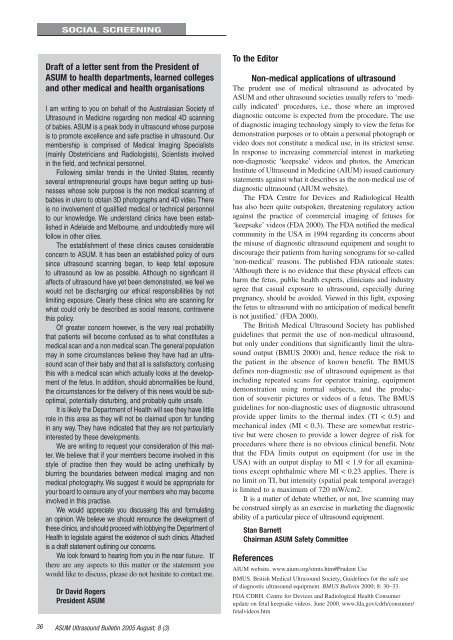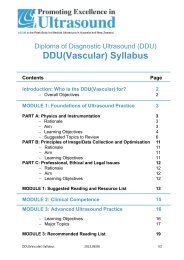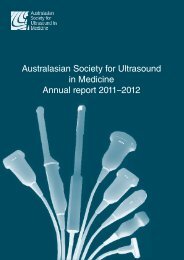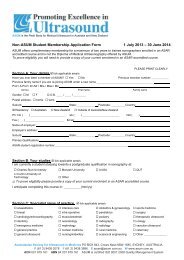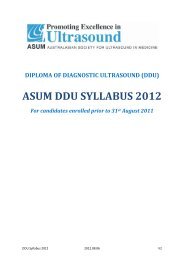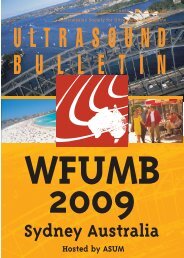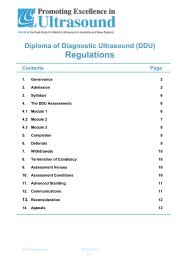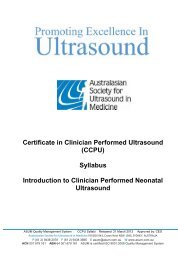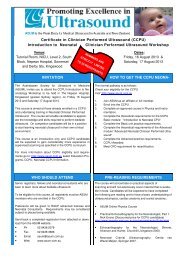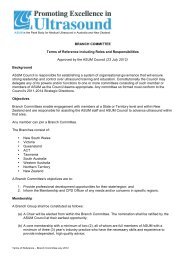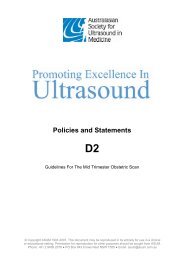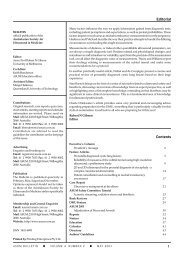Volume 8 Issue 3 - Australasian Society for Ultrasound in Medicine
Volume 8 Issue 3 - Australasian Society for Ultrasound in Medicine
Volume 8 Issue 3 - Australasian Society for Ultrasound in Medicine
You also want an ePaper? Increase the reach of your titles
YUMPU automatically turns print PDFs into web optimized ePapers that Google loves.
SOCIAL SCREENINGDraft of a letter sent from the President ofASUM to health departments, learned collegesand other medical and health organisationsI am writ<strong>in</strong>g to you on behalf of the <strong>Australasian</strong> <strong>Society</strong> of<strong>Ultrasound</strong> <strong>in</strong> Medic<strong>in</strong>e regard<strong>in</strong>g non medical 4D scann<strong>in</strong>gof babies. ASUM is a peak body <strong>in</strong> ultrasound whose purposeis to promote excellence and safe practise <strong>in</strong> ultrasound. Ourmembership is comprised of Medical Imag<strong>in</strong>g Specialists(ma<strong>in</strong>ly Obstetricians and Radiologists), Scientists <strong>in</strong>volved<strong>in</strong> the field, and technical personnel.Follow<strong>in</strong>g similar trends <strong>in</strong> the United States, recentlyseveral entrepreneurial groups have begun sett<strong>in</strong>g up bus<strong>in</strong>esseswhose sole purpose is the non medical scann<strong>in</strong>g ofbabies <strong>in</strong> utero to obta<strong>in</strong> 3D photographs and 4D video. Thereis no <strong>in</strong>volvement of qualified medical or technical personnelto our knowledge. We understand cl<strong>in</strong>ics have been established<strong>in</strong> Adelaide and Melbourne, and undoubtedly more willfollow <strong>in</strong> other cities.The establishment of these cl<strong>in</strong>ics causes considerableconcern to ASUM. It has been an established policy of ourss<strong>in</strong>ce ultrasound scann<strong>in</strong>g began, to keep fetal exposureto ultrasound as low as possible. Although no significant illaffects of ultrasound have yet been demonstrated, we feel wewould not be discharg<strong>in</strong>g our ethical responsibilities by notlimit<strong>in</strong>g exposure. Clearly these cl<strong>in</strong>ics who are scann<strong>in</strong>g <strong>for</strong>what could only be described as social reasons, contravenethis policy.Of greater concern however, is the very real probabilitythat patients will become confused as to what constitutes amedical scan and a non medical scan. The general populationmay <strong>in</strong> some circumstances believe they have had an ultrasoundscan of their baby and that all is satisfactory, confus<strong>in</strong>gthis with a medical scan which actually looks at the developmentof the fetus. In addition, should abnormalities be found,the circumstances <strong>for</strong> the delivery of this news would be suboptimal,potentially disturb<strong>in</strong>g, and probably quite unsafe.It is likely the Department of Health will see they have littlerole <strong>in</strong> this area as they will not be claimed upon <strong>for</strong> fund<strong>in</strong>g<strong>in</strong> any way. They have <strong>in</strong>dicated that they are not particularly<strong>in</strong>terested by these developments.We are writ<strong>in</strong>g to request your consideration of this matter.We believe that if your members become <strong>in</strong>volved <strong>in</strong> thisstyle of practise then they would be act<strong>in</strong>g unethically byblurr<strong>in</strong>g the boundaries between medical imag<strong>in</strong>g and nonmedical photography. We suggest it would be appropriate <strong>for</strong>your board to censure any of your members who may become<strong>in</strong>volved <strong>in</strong> this practise.We would appreciate you discuss<strong>in</strong>g this and <strong>for</strong>mulat<strong>in</strong>gan op<strong>in</strong>ion. We believe we should renounce the development ofthese cl<strong>in</strong>ics, and should proceed with lobby<strong>in</strong>g the Department ofHealth to legislate aga<strong>in</strong>st the existence of such cl<strong>in</strong>ics. Attachedis a draft statement outl<strong>in</strong><strong>in</strong>g our concerns.We look <strong>for</strong>ward to hear<strong>in</strong>g from you <strong>in</strong> the near future. Ifthere are any aspects to this matter or the statement youwould like to discuss, please do not hesitate to contact me.Dr David RogersPresident ASUMTo the EditorNon-medical applications of ultrasoundThe prudent use of medical ultrasound as advocated byASUM and other ultrasound societies usually refers to ‘medically<strong>in</strong>dicated’ procedures, i.e., those where an improveddiagnostic outcome is expected from the procedure. The useof diagnostic imag<strong>in</strong>g technology simply to view the fetus <strong>for</strong>demonstration purposes or to obta<strong>in</strong> a personal photograph orvideo does not constitute a medical use, <strong>in</strong> its strictest sense.In response to <strong>in</strong>creas<strong>in</strong>g commercial <strong>in</strong>terest <strong>in</strong> market<strong>in</strong>gnon-diagnostic ‘keepsake’ videos and photos, the AmericanInstitute of <strong>Ultrasound</strong> <strong>in</strong> Medic<strong>in</strong>e (AIUM) issued cautionarystatements aga<strong>in</strong>st what it describes as the non-medical use ofdiagnostic ultrasound (AIUM website).The FDA Centre <strong>for</strong> Devices and Radiological Healthhas also been quite outspoken, threaten<strong>in</strong>g regulatory actionaga<strong>in</strong>st the practice of commercial imag<strong>in</strong>g of fetuses <strong>for</strong>‘keepsake’ videos (FDA 2000). The FDA notified the medicalcommunity <strong>in</strong> the USA <strong>in</strong> 1994 regard<strong>in</strong>g its concerns aboutthe misuse of diagnostic ultrasound equipment and sought todiscourage their patients from hav<strong>in</strong>g sonograms <strong>for</strong> so-called‘non-medical’ reasons. The published FDA rationale states:‘Although there is no evidence that these physical effects canharm the fetus, public health experts, cl<strong>in</strong>icians and <strong>in</strong>dustryagree that casual exposure to ultrasound, especially dur<strong>in</strong>gpregnancy, should be avoided. Viewed <strong>in</strong> this light, expos<strong>in</strong>gthe fetus to ultrasound with no anticipation of medical benefitis not justified.’ (FDA 2000).The British Medical <strong>Ultrasound</strong> <strong>Society</strong> has publishedguidel<strong>in</strong>es that permit the use of non-medical ultrasound,but only under conditions that significantly limit the ultrasoundoutput (BMUS 2000) and, hence reduce the risk tothe patient <strong>in</strong> the absence of known benefit. The BMUSdef<strong>in</strong>es non-diagnostic use of ultrasound equipment as that<strong>in</strong>clud<strong>in</strong>g repeated scans <strong>for</strong> operator tra<strong>in</strong><strong>in</strong>g, equipmentdemonstration us<strong>in</strong>g normal subjects, and the productionof souvenir pictures or videos of a fetus. The BMUSguidel<strong>in</strong>es <strong>for</strong> non-diagnostic uses of diagnostic ultrasoundprovide upper limits to the thermal <strong>in</strong>dex (TI < 0.5) andmechanical <strong>in</strong>dex (MI < 0.3). These are somewhat restrictivebut were chosen to provide a lower degree of risk <strong>for</strong>procedures where there is no obvious cl<strong>in</strong>ical benefit. Notethat the FDA limits output on equipment (<strong>for</strong> use <strong>in</strong> theUSA) with an output display to MI < 1.9 <strong>for</strong> all exam<strong>in</strong>ationsexcept ophthalmic where MI < 0.23 applies. There isno limit on TI, but <strong>in</strong>tensity (spatial peak temporal average)is limited to a maximum of 720 mW/cm2.It is a matter of debate whether, or not, live scann<strong>in</strong>g maybe construed simply as an exercise <strong>in</strong> market<strong>in</strong>g the diagnosticability of a particular piece of ultrasound equipment.Stan BarnettChairman ASUM Safety CommitteeReferencesAIUM website. www.aium.org/stmts.htm#Prudent UseBMUS. British Medical <strong>Ultrasound</strong> <strong>Society</strong>, Guidel<strong>in</strong>es <strong>for</strong> the safe useof diagnostic ultrasound equipment. BMUS Bullet<strong>in</strong> 2000; 8: 30–33.FDA CDRH. Centre <strong>for</strong> Devices and Radiological Health Consumerupdate on fetal keepsake videos. June 2000. www.fda.gov/cdrh/consumer/fetalvideos.htm36 ASUM <strong>Ultrasound</strong> Bullet<strong>in</strong> 2005 August; 8 (3)


